|
|
|
Hansen's Northwest Native Plant Database |
|
|
|
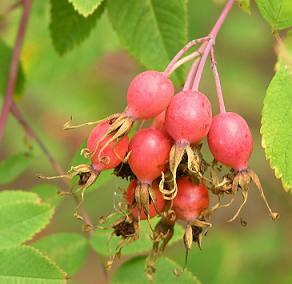 |
||||||||||||||||||||||||||||||
|
This delightful native rose has large, bright, orange hips and clusters of one to three 2" pink flowers with a sweet, almost cinnamon scent. Nootka Rose grows very fast, reaching 3-6' and spreading by suckers to form dense thickets, where birds seek shelter and build their nests. Found from Alaska to California and east to Utah and Colorado, Nootka Rose is hardy from USDA zones 4-9. It likes moisture, but not boggy conditions, and full sun. It is a border plant, found where the forest meets the field, road or sea shore. |
|||||||||||||||||||||||||||||||
| The following article was written by Colleen Stuckey, who lives on Vancouver Island, British Columbia, Canada. | |||||||||||||||||||||||||||||||
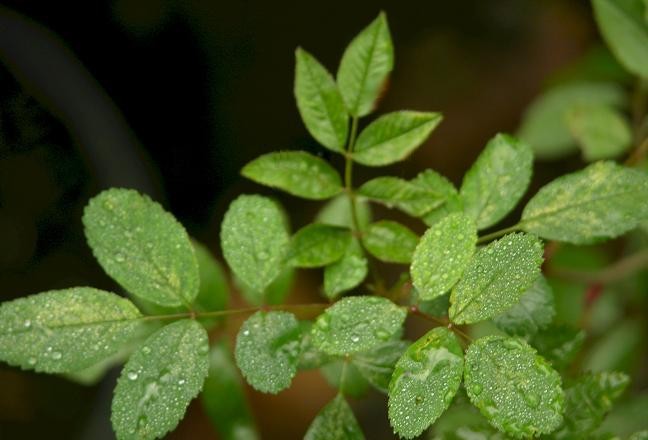 |
The Nootka Rose is an example of a native plant that lends itself well to incorporation in a "tamed" site. Not only will it flourish in a wide variety of situations, many of them problematic for other species, but its neat form and glorious blooms are a striking addition to any garden. If you are fond of roses, this native species offers a fantastic alternative to domesticated varieties. |
||||||||||||||||||||||||||||||
|
|
|||||||||||||||||||||||||||||||
|
All wild roses have distinct features that aid in identification. Bear in mind, however, that the Nootka Rose hybridizes readily with the Clustered Rose (Rosa pisocarpa) and a specimen may not be true to either species. The Nootka Rose is distinguished from other wild roses by three factors: the locations in which it thrives, the hips and the shape of the plant. First, the Nootka Rose grows only in the milder climates, where it will receive a minimum of 270 frost-free days--approximately zones 7b –8b. Therefore, it is found on the coast, along with the Clustered and Bald-Hip Rose (Rosa gymnocarpa), but only in the warmest sites in the interior, where the Wood’s Rose (Rosa woodsii) is common. Unlike the Bald-Hip Rose, which thrives in a more alkaline and shaded woodland sites from sea-level to 5000’ elevation, and the Clustered Rose which prefers a moist location, the Nootka Rose is found in sunny, well-drained locations. Secondly, the hips of the Nootka Rose are large and round, being ½ - ¾” long. In comparison, the Bald-Hip Rose has tiny hips of only ¼”, the Clustered Rose has larger, oblong hips. Lastly, the Nootka Rose grows upright from 3-6’, with stiff, erect branches. Conversely, the Clustered Rose is a larger plant, growing readily to 10’ with gracefully arching branches. The Bald-Hip Rose is much smaller, growing only to 3’. |
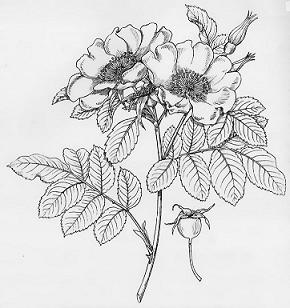 |
||||||||||||||||||||||||||||||
|
|
|||||||||||||||||||||||||||||||
|
Habitat And Range: Nootka Roses are generally found on the borders between the forest and cleared areas such as fields, highways or the beachfront. Their range stretches from coastal Alaska to northern California and eastwards into the interior of British Columbia, Utah and Colorado, in warm, extremely sheltered sites. Ornamental Value: Nootka Roses are every bit as stunning as their domesticated cousins but require less care. Indeed their life cycle is far more noticeable: in spring they appear delicate, with their tiny, intricate foliage unfurling; by summer they are covered in graceful flowers and their mild scent permeates the air; then in autumn, and they loose their leaves and stand with bare and striking red branches to brace the winter deluges. |
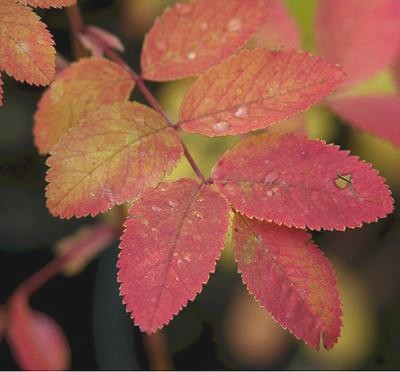 |
||||||||||||||||||||||||||||||
|
|
|||||||||||||||||||||||||||||||
|
Hummingbirds and bees feed on the nectar and pollen of the flowers in summer. Nootka Rose can be used alone or interspersed with evergreen natives for year-round privacy: Tall Oregon Grape (Mahonia aquifolium), Evergreen Huckleberry (Vaccinium ovatum) or Salal (Gaultheria shallon) as examples. |
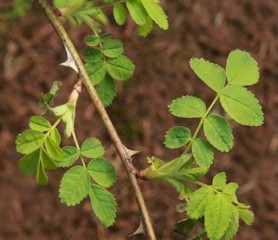 |
||||||||||||||||||||||||||||||
|
|
|||||||||||||||||||||||||||||||
|
Edible and Medicinal Uses: The Nootka Rose can serve as a food and vitamin supplement if care is taken. Before consuming any wild plant be absolutely certain that you have properly identified the plant. Use extreme caution in preparation as many wild plants have toxic parts (for example, the roots may be poisonous but not the leaves of some species) and check with a health care professional before using any wild plant medicinally. Lastly, do not over-harvest: leave ample fruit for reseeding and wildlife food. |
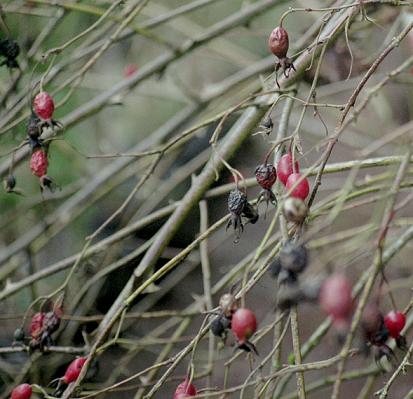 |
||||||||||||||||||||||||||||||
|
|
|||||||||||||||||||||||||||||||
|
I prepare a wintertime syrup for my family to fight colds and flus. I bring to a boil one part whole rosehips to four parts water. As soon as it boils I turn down the heat and simmer for about half an hour. I then strain out the hips, return the liquid to a simmer and when it has reduced to a quarter of its initial volume, I add honey to taste and bottle it up. I store this in the fridge and it never lasts long enough! Roses have edible petals: a striking addition to cream soup or an
elegant garnish on a dessert plate. The
bitter white base should be trimmed off before using. It is claimed that the seeds of the Nootka Rose and all wild roses can be used as a source of vitamin E. However, great care must be taken to rub the hairs off of the seed, as they are extremely irritating to the digestive tract. Open the hips with fingernails or by flattening them with the side of a butcher knife. Scoop out the seed and remove the hairs, then grind them in a blender and add them to food. |
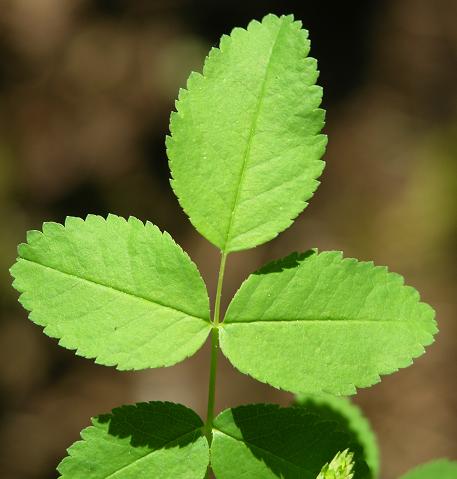 |
||||||||||||||||||||||||||||||
|
|
|||||||||||||||||||||||||||||||
|
Plant Associations: If planting the Nootka Rose on a steep slope for erosion control,
try combining it with native lupines, which are equally capable of growing
on hillsides. Not only will they compliment each other aesthetically, but
also the lupines will serve to “feed” the roses. Being legumes,
lupines fix nitrogen from the air and store it in nodules in the roots,
making it available to nearby plants. Another valuable combination is the Nootka Rose with members of the allium (onion) family, whether native or domesticated species. Alliums serve to repel insects that feed on foliage, attract beneficial insects and bees when in flower and prevent disease such as black spot and mildew. Living on Vancouver Island, which was relatively undisturbed by western civilization until very recently, we are so fortunate to live amongst the native plants and forests. In lambing season, we drive slowly down the winding country roads that parallel the coastline in this magical Pacific Northwest. We pull over to the side of the road and venture out on foot in hopes of spotting the frisky newborns. Keeping a respectful distance from the thorny branches, we rush to the thick hedges of wild Nootka Roses that demarcate the fields. The February skies are cloudy and gray: a sharp contrast to the erect, maroon branches, barren now of all but their brilliant hips. There we see the flocks, huddled together under the majestic stands of Garry Oaks (Quercus garryana). The rugged landscape is softened by the faint bleating of the lambs, by the sight of the ewes, standing patiently while their babies kneel to nurse and by the ever-present song of the birds, scurrying about the rose bushes. |
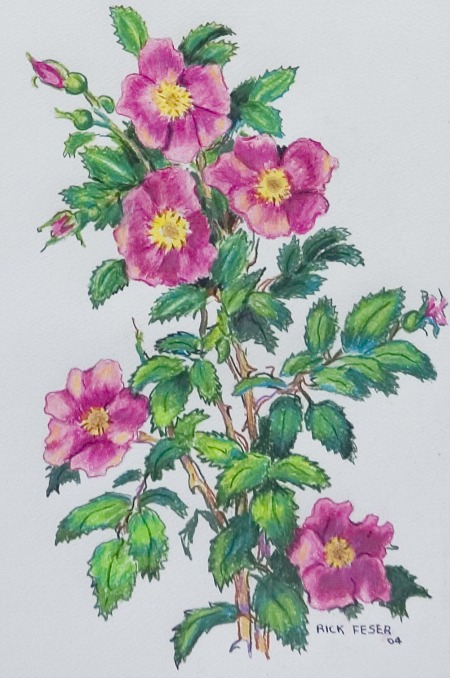 Painting by Rick Feser |
||||||||||||||||||||||||||||||
|
Come spring the hedges will fill out with their delicate foliage, making it harder to see these same lambs. Then summer, and the Nootka Roses will take our breath away with their stunning display of fragile pink blooms and their intoxicating scent. We will forget the flocks of sheep, marveling at the roses flaunting their beauty for the world to see. As summer recedes, the rosehips will form, their vibrant color highlighted in the low, autumn sun. Then winter, the leaves drop and we are once again privy to the activity of the sheep flocks. So vivid are the contrasts between the irregular shoreline and the neat, linear fields, the newborn lambs and the age-old Garry Oaks, the soft fleece and the sharp thorns. The meeting of wild and domesticated is so poignant in this small stretch of the Pacific Coast, where the forests enclose the suburbs, and the farmland is carved in tiny patches from the wild meadows. For a short comparison of northwest native roses, click here. |
|||||||||||||||||||||||||||||||
|
Photos We Share!
|
|||||||||||||||||||||||||||||||
|
Bibliography:
Klinka, K.; Krajina, V.J.; Ceska, A.; and Scagel, A.M. Indicator Plants of Coastal British Columbia. Vancouver, British Columbia: University of British Columbia Press, 1989 Macher, Ron with foreword by H. Kerr, Jr. Making Your Small Farm Profitable. Vermont: Storey Books, 1999 Pettinger, April. Native Plants in the Coastal Garden: A Guide for Gardeners in British Columbia and the Pacific Northwest. Vancouver, British Columbia: Whitecap Books, 1996 Toogood, Alan. Plant Propagation Made Easy. London, England: Dent Co., 1993 Turner, Nancy J. Food Plants of British Columbia Indians. Victoria, BC: British Columbia Provincial Museum, 1978 Vermeulen, Nico. Encyclopedia of Herbs. Vancouver, British Columbia, 1998 Plants for a Future (September, 2001) http://www.comp.leeds.ac.uk/pfaf United States Department of Agriculture, Natural Resource
Conservation Service (April, 2002) http://plants.usda.gov Washington State Native Plant Society. 7400 Sand Pt. Way NE, Seattle, WA 98115. (March, 2002) http://www.wnps.org |
|||||||||||||||||||||||||||||||
|